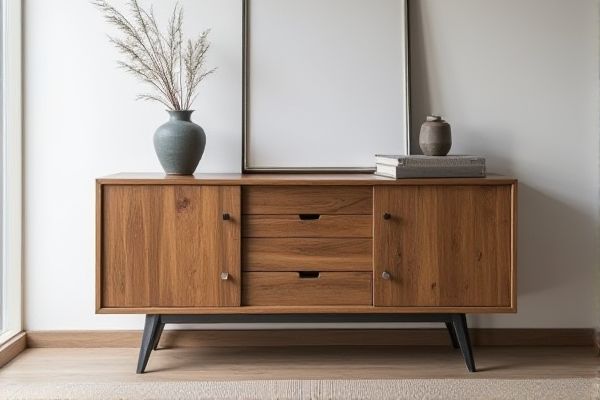
Metal consoles offer durability and a sleek, modern aesthetic that complements contemporary interiors, while wood consoles bring warmth, natural texture, and a timeless appeal to any space. Discover which console best suits Your style and functionality needs by exploring the full comparison in the article.
Table of Comparison
| Feature | Metal Console | Wood Console |
|---|---|---|
| Durability | Highly durable, resistant to impact and corrosion | Moderately durable, prone to scratches and dents |
| Weight | Heavier, provides stability | Lighter, easier to move |
| Maintenance | Low maintenance, easy to clean | Requires regular polishing and protection from moisture |
| Appearance | Modern, industrial look | Classic, warm and natural aesthetic |
| Cost | Generally more affordable | Often more expensive due to craftsmanship |
| Customization | Limited design options | Highly customizable with stains and finishes |
| Environmental Impact | Recyclable, but manufacturing can be energy-intensive | Biodegradable, renewable resource if sourced responsibly |
Introduction to Metal and Wood Consoles
Metal consoles feature durable construction with sleek, contemporary designs that offer high strength and resistance to wear, making them ideal for modern interiors. Wood consoles bring warmth and natural beauty through grain patterns and rich textures, providing timeless elegance and versatility in various decor styles. Both materials deliver unique aesthetic and functional benefits, with metal suited for industrial or minimalist spaces and wood preferred for traditional or rustic environments.
Material Durability: Metal vs Wood
Metal consoles offer superior durability compared to wood, resisting warping, cracking, and insect damage over time. Wood consoles provide a natural aesthetic but require more maintenance to prevent wear from moisture and pests. Choosing metal ensures long-lasting structural integrity, while wood may need refinishing to maintain its appearance and strength.
Aesthetics and Style Comparison
Metal consoles offer a sleek, modern aesthetic characterized by clean lines and industrial appeal, making them ideal for contemporary or minimalist interiors. Wood consoles provide warm, natural textures and classic charm, often featuring intricate grain patterns and a variety of finishes that complement traditional or rustic styles. Your choice depends on whether you prefer the bold, edgy look of metal or the timeless, inviting feel of wood.
Maintenance and Cleaning Differences
Metal consoles require minimal maintenance, often needing only occasional dusting and wiping with a damp cloth to prevent rust and maintain their sleek finish. Wood consoles demand more frequent care, including polishing, treating for scratches, and avoiding exposure to moisture to prevent warping or cracking. Understanding these differences helps ensure longevity and preserves the aesthetic quality of each console type.
Environmental Impact and Sustainability
Metal consoles often have a higher environmental impact due to energy-intensive mining and manufacturing processes, but they can be highly recyclable, reducing long-term waste. Wood consoles, particularly those made from sustainably sourced or reclaimed wood, offer renewable and biodegradable benefits, contributing to carbon sequestration during the tree's growth. Choosing FSC-certified wood consoles ensures better forest management practices, combining durability with lower ecological footprints.
Versatility in Interior Design
Metal consoles offer sleek, modern aesthetics with industrial and minimalist design adaptability, complementing contemporary and urban interiors. Wood consoles bring warmth and natural texture, fitting seamlessly into traditional, rustic, and transitional styles. Their versatility depends on material finish, size, and structural design, allowing customization to suit diverse interior themes and preferences.
Weight and Portability Considerations
Metal consoles typically offer greater durability but tend to be heavier, impacting portability compared to wood consoles. Wood consoles are often lighter and easier to move, making them ideal for spaces where mobility is a priority. Choosing between metal and wood depends on balancing weight requirements with durability and ease of transport.
Cost Analysis: Metal Console vs Wood Console
Metal consoles typically have a higher initial cost due to material expenses and manufacturing complexity, but they offer greater durability and lower maintenance costs over time. Wood consoles often present a more affordable upfront investment, especially when using common hardwoods, yet they may require periodic refinishing and care that increase long-term costs. Evaluating total cost of ownership reveals that metal consoles provide better value in industrial and high-usage settings, while wood consoles suit budget-conscious consumers prioritizing aesthetic warmth and traditional appeal.
Customization and Personalization Options
Metal consoles offer sleek, modern aesthetics with options for powder coating and laser-cut designs, allowing for precise customization of colors and patterns. Wood consoles provide versatile personalization through stain choices, carving details, and the ability to blend different wood types for a unique, warm appearance. Your choice depends on whether you prioritize industrial durability or the natural, handcrafted feel for personalized interior design.
Final Verdict: Which Console is Right for You?
Metal consoles offer durability and a sleek, modern aesthetic ideal for industrial or contemporary spaces, while wood consoles provide warmth and timeless charm with versatile design options for traditional or rustic interiors. Your choice depends on whether you prioritize sturdiness and minimalist style or natural textures and classic appeal. Consider your room's decor and functional needs to determine which console complements your space best.
 homyna.com
homyna.com